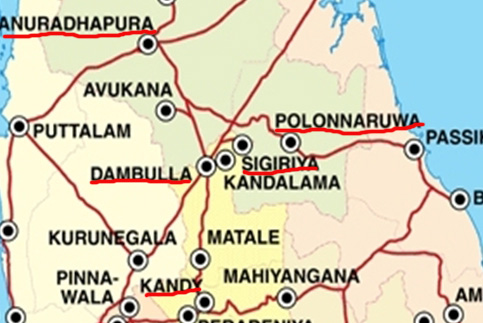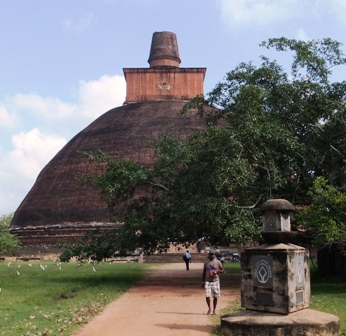Sri Lanka 2013
Episode 10: Hello Anuradhapura, goodbye Sigiriya

Click the photo above to see an album of photos. Close the window to return to this page
Read Previous Episode 9: Polonnaruwa or Next Episode 11: Negombo|
January 24 2013 Anuradhapura
We should have climbed Sigiryia Rock with Parmala the afternoon
we arrived in Sigiryia but we didn't want to rush and do
everything in one day. The next day we woke up to rain, pouring
rain in the morning. We cancelled our planned visit to the Rock.
Ray suggested we take the bus into Sigiryia to look around. The
rain let up later in the morning, so off we went. We walked
about 2 km towards Sigiryia before the local bus caught up to
us. It was crowded but the trip was short. We got off right at
the road leading to the site. Ray took a photo of the hill from
the road. The rain was holding off enough that we considered
walking up, after we had some lunch. A woman was making rotis at
a small roadside stand, We took a table and ordered vegetable
rotis, which were fresh and very good. A Dutch couple sitting at
the next table had a tandem bicycle parked beside the stand.
They were cycling independently in Sri Lanka and had arrived the
day before after three long days bicycling from Jaffna. They had
climbed up Sigiryia rock that morning and got soaked while on
top. The husband showed us an omenous video taken on his phone
of the black storm clouds approaching the rock. The rain started
again as we were eating, hard enough that we spent another hour
waiting the storm out, cancelling Sigiryia once again.
We took a tuk-tuk back to Globetrotters Guesthouse. The rain continued for the rest of the afternoon. We booked a room in Anuradhapura for tomorrow night, intending to spend the morning climbing Sigiryia or if not, going straight to Anuradhapura. It rained all night and threatened rain in the morning so we cancelled Sigiryia for the 3rd and last time. Raja, our guesthouse host, drove us to Dambulla where we got the express bus to Anuradhapura. The whole route was under construction so I was surprised we arrived in just 1 ½ hrs at 10:30 AM. Construction has been the name of the game in Sri Lanka but the roads are sorely in need of repair, so we can’t complain. It just makes for a bumpy ride. At least it was nice and sunny in Anuradhapura. King Pandukabhaya established Anuradhapura as the capital of Sri Lanka in the 4thcentury BC and laid out the city according to a well designed plan that was followed by successive kings until the the 11th century AD. For 1400 years Anuradhapura remained the most stable center of political power and urban life in Asia until the capital was overtaken by Polonnaruwa, the ancient city we visited a few days before. We rented bicycles for Saturday and Sunday to ride to the archaeological sites in town. There is no multi-day ticket for the sites anymore. That option was cancelled in 2012, much to the chagrin of locals and tourists. Instead we visited a few of the extra charge sites the first day and bought a day pass for the second day. The whole country was taking a long weekend to celebrate the full moon poya day, which in January celebrates the first visit of Buddha to Sri Lanka. That means that the favourite temples were going to be filled with people, all wearing their white, temple going clothes. We got a warm-up for the throngs at Isurumuniya Vihara, a large white 3rd century BC stupa temple built into a rock. We had to line up to visit the main shrine with its Buddhas in front of the rock but everyone was very accommodating. There were several excellent rock carvings, a view from a terrace at the top of the rock and a small museum, (no photos allowed), displaying the most valuable carvings found at the site. Leaving Isurumuniya, we biked a short distance down a road to Vessagiriya, a collection of giant boulders that had inaccessible cave temples and the ruins of a small monastery. Another short ride brought us to the main event of the day, witnessing the morning puja ceremony at Sri Maha Bodhi. The parking lot was full of buses, minivans, tuk-tuks and cars and the grounds immediately surrounding the temple were crowded with worshippers. The temple was erected to worship the sacred bodhi tree, under which Gautama Buddha is said to have achieved enlightenment. Shoots from the original bodhi (a fig tree variety) were brought from India and planted at this spot in 288 BC, making it the oldest existing bodhi tree in the world. There are now several bodhi trees at the temple, all started from shoots of the oldest, the most sacred, which occupies a prime spot on a platform, accessible by only a very few of the resident monks and officials. The rest of the people sat near the offshoots, all of which had prayer flags and white banners tied to their branches. During and after the puja ceremony, lines of devotees climbed the steps to the main shrine to proffer their flower and fruit offerings. Our first day finished with a visit to another Buddhist temple, the huge, white reversed bell shaped Mirisavatiya Dagoba, built in the 2nd century BC. It’s creation was an interesting legend. We took a photo of the plaque giving the story, which we included with the Picasa photos. All the dagobas have a smaller shrine at each of the four cardinal points around the perimeter. It is considered auspicious to circle the dagoba in a clockwise direction, offering prayers and flowes at each shrine. We walked around the dagobas, but didn’t bother with the prayers. You cannot visit Anuradhapurna without visiting the huge, red brick Jetavanarama Dagoba. That was our starting point for Sunday. To get to the dagoba, we walked through the ruins of a monastery complex that once housed 3000 monks. Jetavanarama Dagoba was 100m high when it was built in the 3rdcentury BC. It was the third highest monument in the world, after the Egyptian pyramids. Now it seems to have shrunk to 70m, but it is still impressive. There were several beautiful carved stone decorations to admire, painted Buddha figures, and a Grey Langur monkey having lunch on the temple flowers someone left as an offering on one of the perimeter shrines. A nice bicycle ride through shaded country roads, past green rice paddies brought us to Abhayagiri Monastery complex. We followed a bus load of Sri Lankans on a day outing to pay their respects to the temples of Anuradhapura. Their first stop was at the 4th century seated Samadi Buddha, considered one of the finest Buddha statues in Sri Lanka. From there it was just a short walk through a forest to another huge, red brick dagoba. Abhayagiri Dagoba, built in the 1st or 2nd century BC, was the center point for a monastery housing 5000 monks. The original white stucco eventually wore away, allowing jungle plants to grow over the brick exterior. A project to clear all the green, jungle growth from the exterior has been ongoing for the last 15 years and is not finished yet. Two smaller building ruins nearby Abhayagiri had interesting carvings. A carved moonstone, with bands of elephants, horses, bulls and lions led the way to a school for monks. Ratnaprasada temple had some of the most elaborately carved guardstones we had seen. A Hindu-style deity, himself protected by a multi-headed cobra, is topped by a dragon figure spewing forth a pair of lovers. You have to look at our photo closely to pick out the details. Pedalling back to town, we realized we were passing a smaller white dagoba temple that graces the cover of the latest edition of Lonely Planet for Sri Lanka. Thuparama is the oldest dagoba in Sri Lanka and is said to contain the right collarbone of the Buddha. 176 Slim stone pillars once enclosed the shrine in four concentric circles, of which just 41 still stand. And so our Ancient Cities visits ended. It was extremely interesting, but we were almost templed out. We need a break before tackling the temples of India, where we are headed next Thursday. Read Previous Episode 9: Polonnaruwa or Next Episode 11: Negombo Read India 2013 Return to Sri Lanka Intro Return to Travels or Introduction |
